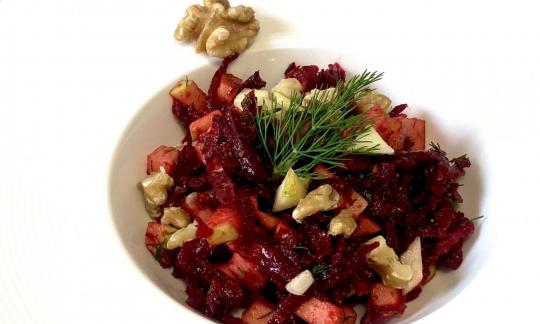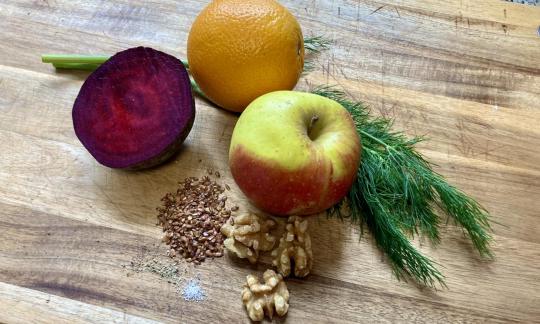Healthy, oil-free beetroot salad with apple
raw-vegan
Ingredients (for servings, )
| For the salad | |
|---|---|
| 1 | Beetroot, raw (organic?) (5.5 oz) |
| 1 | Apple, raw, with peel (5.3 oz) |
| For the dressing | |
| 2 tbsp, ground | Linseed, raw, organic? (golden linseed, flax) (0.49 oz) |
| 1 | Oranges, raw (organic?) (4.6 oz) |
| 1 dash | Table salt (table salt, raw?, organic?) (0.01 oz) |
| 1 dash | Black pepper (organic?, raw?) (0.00 oz) |
| Optional | |
| 1 tsp | Lemon juice (raw?, organic?) (0.09 oz) |
| topping | |
| ⅔ oz | Walnuts (tree nuts), raw (organic?) |
| 2 sprigs | Dill, raw (herb, seeds, organic?) (0.01 oz) |
Equipment
- grater
- coffee grinder, electric
- citrus juicer (lemon squeezer)
Type of preparation
- chop or grind
- food preparation without heating
- squeeze
- grate (shred)
Preparation
For the salad
Peel the beetroot and grate coarsely. Wash the apple, remove the core and dice.For the amount of 2 portions we used a small to medium sized beetroot (150-200 g).
For the dressing
Grind the flaxseed in a coffee grinder. Squeeze the orange. Put both in a screw-top jar and mix thoroughly with salt and pepper.Optional: Depending on the acidity of the apples, add some lemon juice.
Finishing the salad
Chop walnuts. Wash dill and chop finely.
Mix the salad with the dressing. Top with walnuts and dill and serve.You can also enjoy the salad with lettuce or lamb's lettuce. To do this, increase the amount of dressing accordingly.
|
Nutritional Information per person
Convert per 100g
|
2000 kcal | |
|---|---|---|
| Energy | 206 kcal | 10.3% |
| Fat/Lipids | 9.8 g | 14.0% |
| Saturated Fats | 0.92 g | 4.6% |
| Carbohydrates (inc.dietary fiber) | 29 g | 10.7% |
| Sugars | 20 g | 21.8% |
| Fiber | 8.2 g | 32.6% |
| Protein/Albumin | 4.9 g | 9.8% |
| Cooking Salt (Na:141.4 mg) | 359 mg | 15.0% |
| Essential micronutrients with the highest proportions | per person | 2000 kcal | |
|---|---|---|---|
| Fat | Alpha-Linolenic acid; ALA; 18:3 omega-3 | 2.5 g | 126.0% |
| Vit | Vitamin B9, B11 (Folate, as the active form of folic acid) | 123 µg | 62.0% |
| Vit | Vitamin C (ascorbic acid) | 43 mg | 54.0% |
| Fat | Linoleic acid; LA; 18:2 omega-6 | 4.3 g | 43.0% |
| Min | Manganese, Mn | 0.82 mg | 41.0% |
| Min | Copper, Cu | 0.35 mg | 35.0% |
| Elem | Potassium, K | 556 mg | 28.0% |
| Prot | Tryptophan (Trp, W) | 0.06 g | 24.0% |
| Vit | Vitamin B1 (Thiamine) | 0.24 mg | 22.0% |
| Vit | Vitamin B7 (Biotin, ex vitamin H) | 9.8 µg | 20.0% |
Detailed Nutritional Information per Person for this Recipe
The majority of the nutritional information comes from the USDA (US Department of Agriculture). This means that the information for natural products is often incomplete or only given within broader categories, whereas in most cases products made from these have more complete information displayed.
If we take flaxseed, for example, the important essential amino acid ALA (omega-3) is only included in an overarching category whereas for flaxseed oil ALA is listed specifically. In time, we will be able to change this, but it will require a lot of work. An “i” appears behind ingredients that have been adjusted and an explanation appears when you hover over this symbol.
For Erb Muesli, the original calculations resulted in 48 % of the daily requirement of ALA — but with the correction, we see that the muesli actually covers >100 % of the necessary recommendation for the omega-3 fatty acid ALA. Our goal is to eventually be able to compare the nutritional value of our recipes with those that are used in conventional western lifestyles.
| Essential fatty acids | per person | 2000 kcal |
|---|---|---|
| Alpha-Linolenic acid; ALA; 18:3 omega-3 | 2.5 g | 126.0% |
| Linoleic acid; LA; 18:2 omega-6 | 4.3 g | 43.0% |
| Essential amino acids | per person | 2000 kcal |
|---|---|---|
| Tryptophan (Trp, W) | 0.06 g | 24.0% |
| Threonine (Thr, T, irreversibly transaminated) | 0.16 g | 18.0% |
| Isoleucine (Ile, I) | 0.18 g | 15.0% |
| Valin (Val, V) | 0.23 g | 14.0% |
| Phenylalanine (Phe, F) | 0.20 g | 13.0% |
| Leucine (Leu, L) | 0.28 g | 12.0% |
| Lysine (Lys, K, irreversibly transaminated) | 0.19 g | 10.0% |
| Methionine (Met, M) | 0.08 g | 8.0% |
| Vitamins | per person | 2000 kcal |
|---|---|---|
| Vitamin B9, B11 (Folate, as the active form of folic acid) | 123 µg | 62.0% |
| Vitamin C (ascorbic acid) | 43 mg | 54.0% |
| Vitamin B1 (Thiamine) | 0.24 mg | 22.0% |
| Vitamin B7 (Biotin, ex vitamin H) | 9.8 µg | 20.0% |
| Vitamin B6 (pyridoxine) | 0.21 mg | 15.0% |
| Vitamin B5 (Pantothenic acid) | 0.46 mg | 8.0% |
| Vitamin B2 (Riboflavin) | 0.10 mg | 7.0% |
| Vitamin B3 (Niacin) | 0.85 mg | 5.0% |
| Vitamin E, as a-TEs | 0.38 mg | 3.0% |
| Vitamin K | 2.5 µg | 3.0% |
| Vitamin A, as RAE | 12 µg | 1.0% |
| Essential macroelements (macronutrients) | per person | 2000 kcal |
|---|---|---|
| Potassium, K | 556 mg | 28.0% |
| Magnesium, Mg | 72 mg | 19.0% |
| Phosphorus, P | 128 mg | 18.0% |
| Sodium, Na | 141 mg | 18.0% |
| Calcium, Ca | 72 mg | 9.0% |
| Essential trace elements (micronutrients) | per person | 2000 kcal |
|---|---|---|
| Manganese, Mn | 0.82 mg | 41.0% |
| Copper, Cu | 0.35 mg | 35.0% |
| Iron, Fe | 1.5 mg | 11.0% |
| Zinc, Zn | 0.96 mg | 10.0% |
| Selenium, Se | 3.1 µg | 6.0% |
| Iod, I (Jod, J) | 1.6 µg | 1.0% |
| Fluorine, F | 2.5 µg | < 0.1% |
This healthy, oil-free beetroot salad with apple is easy to make and tastes wonderfully fruity.
Nutrient profile: According to GDA guidelines, one portion of this dish covers more than 100% of the daily requirement of omega-3 fatty acids. Folic acid is covered by a good 60% and vitamin C by over 50%. The ratio of essential omega-6 and omega-3 fatty acids is 2:1, well below the maximum recommended ratio of 5:1. More on this under: Vegans often eat unhealthily. Avoidable nutritional errors.
Beetroot: Beetroot, also known as beetroot, belongs to the Amaranth family. The characteristic red color is mainly due to the high concentration of the glycoside betanin. Due to its high content of vitamin B, potassium, iron and folic acid, beetroot is a healthy vegetable that can be used cooked or raw in salads.
Walnut: The real walnut, also called tree nut, has the highest proportion of linolenic acid (an omega-3 fatty acid that is good for the heart) of all nuts. It also has health benefits thanks to tocopherols (forms of vitamin E) and many macro and trace elements.
Flaxseed: Flaxseed has a slightly nutty taste. The fat content of 40% contains about 50% of the polyunsaturated omega-3 fatty acid alpha-linolenic acid and thus the highest concentration of omega-3 fatty acids of all known vegetable oils.
Orange juice: Orange juice, also known as OJ or orange juice, has a high vitamin C content. This amounts to just over 50 mg in 100 ml, i.e. more than 50% of the recommended daily requirement according to the GDA recommendation. Orange juice is the most consumed juice in the world, with the lion's share of exports coming from Brazil.
Dill: Dill is an annual herbaceous plant and a member of the Apiaceae family. Dill is widespread in Eurasia and its seeds are used as a herb or spice in aromatic dishes. The flavor of dill leaves is best when used fresh, as they quickly lose their flavor when dried. The dill tips look similar to fennel leaves, but taste very different.
Beetroot: People who are prone to the formation of kidney stones, such as Crohn's disease patients, should only consume beetroot in moderation due to its high oxalic acid content.
Avoid discoloration: Peeling beetroot can cause discoloration on your hands and kitchen utensils.
You can also enjoy the salad withlettuce or lamb's lettuce. To do this, increase the amount of dressing accordingly.






